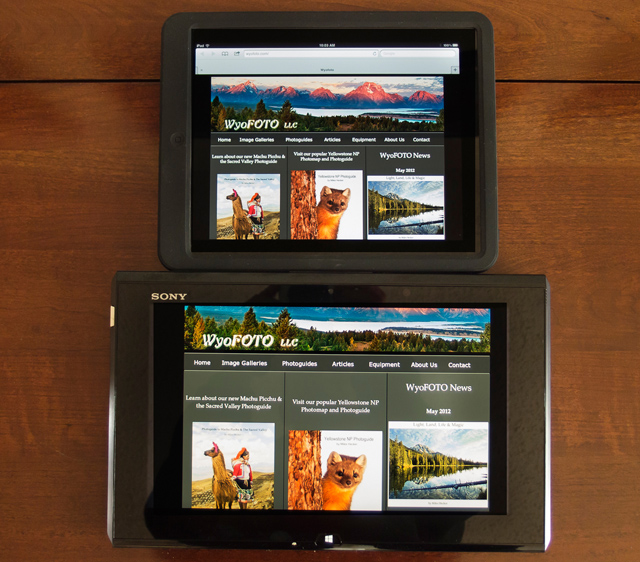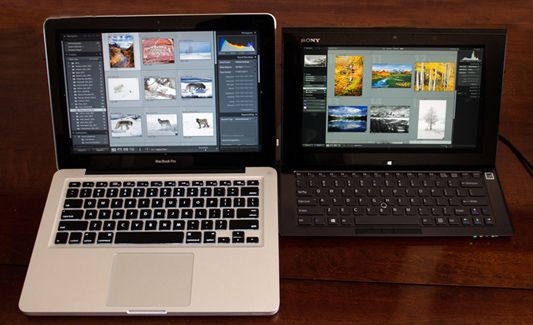A Review of the Sony Duo 11
by Miles Hecker
|
Background
The advent of digital photography brought with it the replacement of the traditional wet darkroom with the modern digital lightroom. In the wet darkroom the main instrument of the photographers trade was of course the enlarger. Similarly in the lightroom the enlarger has been replaced by the modern digital computer which we use to craft our finished images. The lightroom also gave the photographer the ability to evaluate his or her images on the road during a shoot with a portable laptop computer. Recently, a little brother to the laptop, the tablet computer, popularized by the Ipad, gave the photographer further ability to display and evaluate his or her images on a truly tiny portable device while on the road. While many photographers were tempted to totally replace the laptop computer with a tablet computer while traveling, the device often came up short. To start with, tablet computers were not color calibratable, so what you see was not what you get color wise. Furthermore, they were computationally underpowered and as a result robust software applications such as Adobe Photoshop and Adobe Lightroom could not be ported to them for serious photo cataloging and adjustment.
Well as they say, that was then and this is now. With the advent of Intel’s 17 watt Ivy Bridge i7 class CPU, it became possible in late 2012 to build a tablet size computer with the power necessary to run full blown photo editing apps like Photoshop and Lightroom. The launch of Windows 8 in the PC world gave this computer a suitable operating system that was both tablet aware and legacy software compatible. The age of tablet size computers with the power and functionality of laptop computers had arrived.
|
Introduction
We all have different needs when it comes to a portable computer to take on the road for a photographic shoot. For the last several years I have used a 13″ Macbook Pro with a 256GB SSD drive. I had settled on the Macbook, because of its relatively decent LCD screen. Although I am predominantly a Windows user, in 2010 I simply could not find a Windows compatible laptop with a good LCD display. The “market” had demanded low cost and the PC makers had responded with some of the worst LCD displays I had ever seen. They had narrow viewing angles, small color gamuts and horrible flat spots in their color response. That being the case, I went for the Macbook Pro with a 13″ display. It was relatively fast and had a good but not stellar display.
With the advent of the Ipad I purchased a tablet computer. It was small and good for browsing the web, but very limited in its use for a photographic road trip. My wife liked hers just fine. The important difference between us though is my desire to process and evaluate my shots while on the road. She is just happy to delete the real losers and keep the shots with potential. I on the other hand, like to take mid day when the light is often bad, to work on shots, evaluate their tonality and try to turn them into a finished product. The Macbook could pretty much do this. The newer Ipads or any other tablet I could find could simply not perform this task. They were both underpowered and lacking in proper software.
|

Ipad and Sony Duo 11
|
My Perfect Photographers Portable Computer
For me a portable photographers computer must be capable of performing well in three areas. The first of these is cruising the web. While seemingly simple, most tablets don’t do all that well here. Ipads do not support Adobe Flash. While Adobe Flash player was never supported on Ipads, it was supported in version 3 to 4.1 of Android and worked fairly well. As of March 2013, many web sites, including my own wyofoto.com site, still use flash. For example, BBC’s iPlayer relies on Flash for both desktop and mobile video. The only two tablet operating systems to support flash today are Windows 8 and Windows RT. For my purposes then, the perfect portable computer will be running OSX, Windows 8 or Windows RT as its operating system. Of these three, only OSX and Windows 8 supports Adobe Lightroom and Adobe Photoshop. So by default we are looking at a computer that can run OSX or Windows 8.
Secondly, to use Lighroom or Photoshop and get WYSIWYG results color and tonality wise, the LCD screen is very important. Screen wise, we are looking at something in the 10″-12.5″ range to keep the size of the computer manageable. It should have an IPS type screen with a wide viewing angle, and a calibratible color palette approaching that of the sRGB standard. This rules out the Mac Airbook. Its color palette has always looked washed out to me and covers only about 50% of the sRGB color gamut. It should be capable of functioning as both a tablet and an ultrabook type computer with a real keyboard. The keyboard can either be build into the cover or be underneath as in some slider designs. An add on keyboard that doesn’t retract into the computer is one more piece to lose and in my opinion unacceptable. It’s weight should be as light as possible. Something about two pounds would be ideal, but something closer to 3 pounds would be acceptable. It should also have enough CPU power and RAM to run this software with reasonable speed.
The third part of my needs involves having suitable I/O capabilites without the use of add on dongles. I do quite a few presentations to groups using digital projectors. I need to have both old VGA type output as well as newer HDMI digital output. Many new projectors and wide screen TV’s are now coming with Intel WiDi wireless capabilites, so having this also would be a plus. Having an SD card slot is an option all photographers need, as it is widely used by most of the digital camera world. Two USB 3.0 ports are another must have for me. A hardwired gigabit Ethernet port is also desirable. On my network, hardwired transfers of data are 350% quicker than my best wireless transfer speed.
Looking at these criteria, I narrowed my choice to three computers. They were the Lenovo Yoga, Microsoft Surface Pro and the Sony Duo 11. I ruled out the Lenovo Yoga after trying it. I felt its 3.5 pounds and larger than normal tablet size just made it a tad too big. The Microsoft Surface Pro only came with a maximum 4GB RAM and 128GB of SSD storage. This in my opinion, made it a bit under equipped to serve as a photo processing computer. The Sony Duo could be had with a 2GHZ i7 CPU, 8GB of RAM, 256GB of SSD and an 11.6″ IPS screen. It was easily upgradable to a 512GB in the future, if the need should arise. It met all of the criteria I have listed above. Based upon my needs I ordered the Sony Duo 11. A full video review of the Sony Duo 11 can be seen here.
|
|

13″ Macbook Pro and Sony Duo 11
|
The Arrival
The first thing I did after booting my Sony Duo 11 is load the Xrite calibration software and calibrate it at a luminance level of 140 nits with my Eye-One Pro spectrometer. In a word, the display is gorgeous! It has a very wide viewing angle, an excellent color gamut for a portable, which is about 85% of the sRGB space, and very good color uniformity. It is absolutely the best display I’ve seen on any tablet sized device including the Retina display Ipad. Its resolution of 1920×1080 pixels on a 11.6″ display is not quite as dense as an Ipad 3 or 4, but is still superb for reading small text or photo work. If you like numbers, it has a density of 190 pixels/inch vs 300 pixles/inch in the Ipads.
It cold boots Windows 8 from an off state in 6 seconds! The Microsoft Surface Pro takes 25 seconds, an Ipad 3 takes 29 seconds to load iOS and an Ipad 4 takes 19 seconds. That’s about as close to instant on as I’ve seen. The keyboard is much better than a software only touch screen keyboard. It is backlit and a tad smaller than a standard laptop keyboard. While I would not want to write a novel on it, I find it quite adequate for normal tasks like answering emails. Adobe Photoshop CS5 and Lightroom 4.3 installed without a hitch. I was able to copy a 2200 image library over to the Sony and Lightroom functioned quite well with it. I didn’t do an actual speed test, but it’s response was faster than my Macbook Pro. Photoshop worked in a similarly brisk fashion. Now it’s obviously not as fast as my desktop computer, which uses a quad core 4.4GHZ i7-2600K with 16GB of RAM, but it does very well and is fast as any ultrabook PC or Macbook Air.
|
|

Macbook Air Display Viewing Angles

Sony Duo 11 Display Viewing Angles
|
Little Things That Please
I’ve had the Sony Duo 11 about 2 months now. So far every Windows application I’ve loaded on it has worked without a flaw. Both Firefox and Internet Explorer load complex web pages with ease and display them perfectly and quickly, including those with Adobe Flash content. This is in comparison to the slow uncertain results I’ve experienced on all the tablet computers I’ve used.
I work on images in a Lightroom library and transfer them intact with all the edits to my main desktop computer with ease. My gigabit ethernet link moves data between them at a speed of 120Mbytes/sec. It has replaced both my Macbook Pro and a tablet computer with a single easy to use unit.
Is it perfect? No, nothing is or will be. It is pricey, the loaded version I have lists for $1595. This is actually slighlty lower in price than an equivalent 11.6″ Macbook Air. The Macbook Air will not function as a tablet and has IMO a very mediocre screen. The Sony runs about 4 hours on a charge, about half of a workday. You can purchase a thin add on battery that mounts underneath and will double that run time. It’s about 1/4″ thicker and 0.8 pounds heavier than I would like it to be. All in all, it has become this photographers best friend while on the road. Will it be your best friend? That depends on your personal needs and desires and only you can answer that question. If you have a Sony Store in a shopping center near you, you can check it out in person.
|
|






